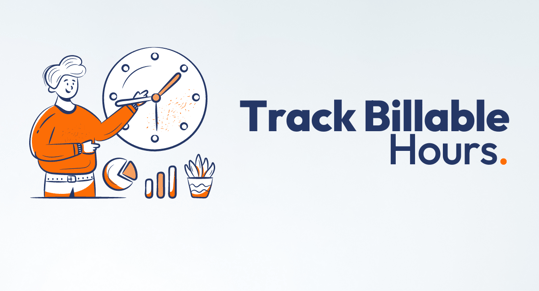Share this
How to Keep Better Track of Your Billable Hours
by Jarno Koopman on November 22, 2023

Billable hours are the lifeblood of consultancy firms and solopreneurs who charge by the hour for their services.
Accurately keeping track of your billable hours is the only way to make sure you’re properly compensated for your efforts when it comes time to invoice.
When you’re working on a project, tracking billable time is crucial to make sure you stay within budget before it’s too late.
To track your billable hours effectively, you’ll need to spring for time-tracking software. That’s a given.
What’s next? Here we’ll tell you where to go from there to make sure no valuable billable time slips through the cracks on your next project.
1. Integrate your time-tracking tool
So you’ve got your time tracking software in-tow, which is a great first step to better billable hours tracking. But to be able to accurately track your billable time and tie these hours to specific projects and tasks, you have to integrate your time-tracking tool with your project management software.
To do that, you have a few options:
- For maximum efficiency, simply use your project management software as your time tracker. All-in-one project management tools like PSOhub provide out-of-box time tracking, meaning your project data is automatically synced with your time tracker. Solutions that provide this functionality are also sometimes referred to as billable hours software.
- If you don’t have project management software with built-in time tracking, the next best thing is to leverage a native integration. For example, Harvest– a popular time tracker– integrates with the project management solution Trello. To connect, you would simply set up the integration that will keep you within those software environments for a seamless experience.
- If your project management tool does not provide a native integration with your time tracking software, you may be able to connect them through a third party like Zapier. Although this won’t give you the most efficiency, a few workarounds can ensure your billable hours get tied to the correct project.
2. Don’t forget your CRM
If you’re using a CRM like Salesforce or HubSpot to win new customers, you’ll want to be sure to integrate your time-tracking tool with these platforms as well. This way, everyone on both the sales and project sides will be tracking time the same way.
Especially if you’re using the HubSpot Service Hub, you’ll want to be sure your time tracking and project management are both connected, so that you can be alerted to billable time that supersedes what’s outlined in your service agreements.
Before you select a time tracking tool, it’s a good idea to make sure it integrates with both your project management AND your CRM for the most seamless, most efficient experience.
3. Know the difference
Your team cannot be expected to accurately account for their billable hours if they don’t know the difference between billable and non-billable time. Not knowing the difference is a super-common way startups, in particular, let billable hours slip through the cracks.
Remember that billable hours include any tasks that relate directly to the project or contract. This includes correspondence with the client, meetings with the client, executing core tasks that move the project forward, etc.
Non-billable time refers to hours spent working that your customer isn’t on the hook for, things like invoicing, internal meetings, making to-do lists, etc.
Make sure that everyone on your team knows the difference between billable and non-billable hours to make sure time is accurately being accounted for.
4. Use a mobile app
Any time-tracking solution worth its snuff will offer a mobile app, enabling you to track time on the go. Encourage your team to download the mobile version of your time tracker and take advantage of it. This way, when work is done outside the office or on the laptop, it will get logged before it’s forgotten.
For example, if someone is out of town and takes 30 minutes to respond to emails about a project, that’s billable time. Let’s say they’re sitting by a pool– It’s way easier to enter that time on the phone versus going inside and opening a laptop. It’s also less likely the billable time will be forgotten.
5. GPS time tracking
For design teams, construction firms, and any other consulting businesses that do work on-site, GPS time tracking can be a real game changer. This is an example of automation offered by various top-notch time-tracking tools and project management software to help increase billability.
With a GPS time tracking feature, no one needs to pull out their phone to log time spent on site. Instead, time will automatically be logged and assigned to the correct project based on the time the person is physically present.
Automation like this is a key feature to look for in your time-tracking tool as well as your project management solution. This will help you reduce time-sucks from repetitive administrative tasks.
6. Further automate your time tracking
If you really want to up your efficiency game and stay on top of your team’s billable utilization like never before, get with the way of the future, or what’s called self-driving time tracking. This software feature leverages machine learning to make it so that your team never has to actually ‘track’ their time at all.
Instead, your project management tool will learn from their calendar and their time spent within the platform to correctly log billable hours. Self-driving time tracking can then even generate an invoice automatically, further automating your admin processes.
How to Save 100 Billable Hours per Year/ per Person
More billability means more productivity and ultimately, more revenue. The key is cutting back on that non-billable time and maximizing both productivity and visibility across your organization.
If you want to save 100 billable hours per person per year (or more), consider adopting PSOhub as your project management solution.
PSOhub’s AI-powered features and easy-to-use, integrated environment help save teams in over 40 countries time, money, and stress.
What would you do with 100 more hours per year? Learn more about how PSOhub saves small businesses money with raw figures here, and take the solution for a spin with a FREE trial today!
Share this
- Project Management (82)
- Productivity (61)
- Time Tracking (26)
- PSA Software (24)
- HubSpot (20)
- Resource Management (13)
- Invoicing (12)
- Salesforce (11)
- AI (7)
- Contract Management (7)
- Profitability (6)
- Gantt Chart (4)
- Microsoft Dynamics (4)
- Budget Management (3)
- Financial services (3)
- Integrations (3)
- Quickbooks (3)
- Quote (3)
- ROI (3)
- Traffic Management (3)
- collaboration (3)
- Consultancy (2)
- Digital Marketing & Advertising (2)
- Pipedrive (2)
- Work Management (2)
- About PSOhub (1)
- Automation (1)
- IT Companies (1)
- Risk Management (1)
- Ticket Sync (1)
- Workload Management (1)
- power bi (1)
- April 2025 (2)
- March 2025 (3)
- February 2025 (3)
- January 2025 (3)
- December 2024 (1)
- November 2024 (5)
- October 2024 (5)
- September 2024 (1)
- August 2024 (4)
- July 2024 (3)
- June 2024 (5)
- May 2024 (4)
- April 2024 (5)
- March 2024 (5)
- February 2024 (4)
- January 2024 (3)
- December 2023 (2)
- November 2023 (7)
- October 2023 (5)
- August 2023 (6)
- July 2023 (2)
- June 2023 (4)
- May 2023 (4)
- April 2023 (3)
- March 2023 (4)
- February 2023 (4)
- January 2023 (3)
- December 2022 (5)
- November 2022 (3)
- October 2022 (4)
- September 2022 (5)
- August 2022 (7)
- July 2022 (1)
- June 2022 (7)
- May 2022 (6)
- April 2022 (2)
- March 2022 (2)
- February 2022 (4)
- January 2022 (4)
- December 2021 (5)
- November 2021 (2)
- October 2021 (2)
- September 2021 (3)
- August 2021 (3)
- July 2021 (2)
- June 2021 (2)
- May 2021 (3)
- April 2021 (2)
- March 2021 (2)
- February 2021 (3)
- January 2021 (5)
- December 2020 (4)
- November 2020 (2)
- October 2020 (4)
- September 2020 (5)
- August 2020 (4)
- July 2020 (4)
- June 2020 (1)
- May 2020 (4)
- April 2020 (8)
- March 2020 (7)


